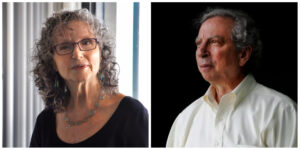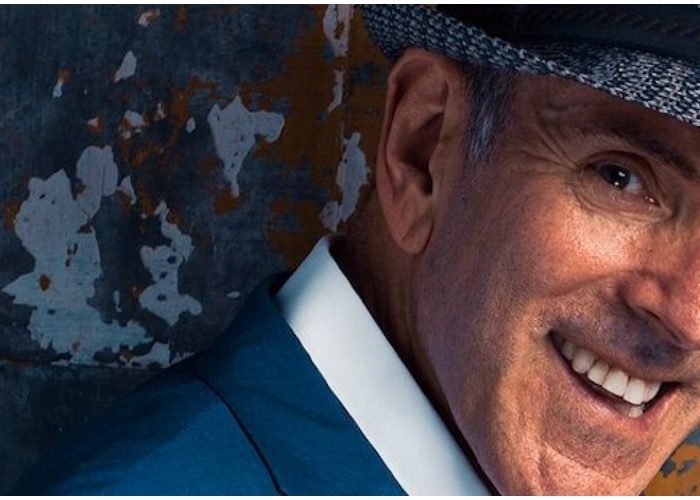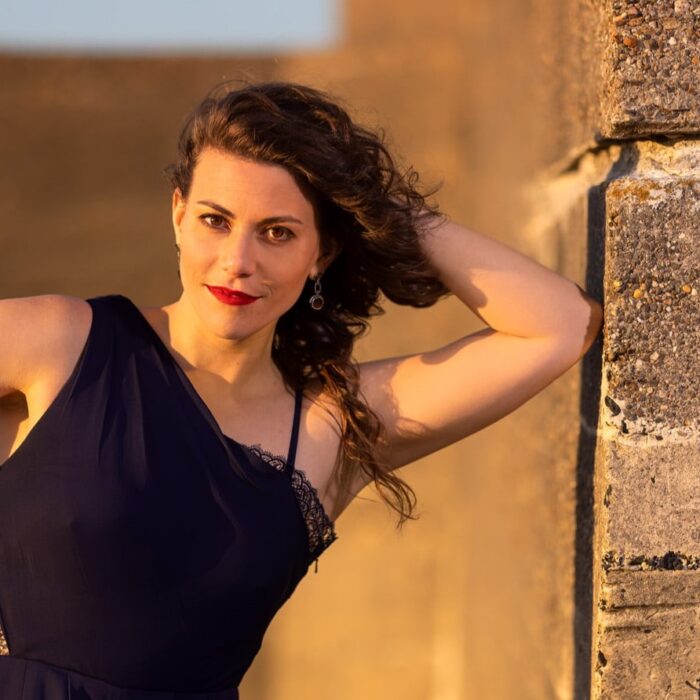
Q &A: Shulamit Ran, Arthur Fagen & Anne Slovin on Bringing ‘Anne Frank’ to Life in Indiana
By David SalazarOn March 3, Indiana University is set to present the world premiere of “Anne Frank” by an all-Jewish team comprising composer Shulamit Ran, librettist Charles Kondek, and conductor Arthur Fagen.
Fagen is a professor of music and chair of the Jacobs School of Music Department of Orchestral Conducting and the son of Holocaust survivors. His mother, Rena, was a prisoner in Auschwitz concentration camp that was saved thanks to German industrialist Oskar Schindler, and the family remained in touch with Schindler after the war. Fagen even credits Schindler with helping kick-start his career as a 21-year-old.
Ran is an Israeli-American composer who won a Pulitzer Prize for Music for her Symphony (1990); she is just the second woman to win a Pulitzer Prize for Music. She also composed the opera “Between Two Worlds (The Dybuk),” as well as several works for chamber ensemble and numerous vocal and choral pieces.
OperaWire spoke with Ran at length as well as Fagen and Anne Dora Slovin, who will perform in the opera.
OperaWire: Where did the idea originate?
Arthur Fagen: As my parents are Schindler’s List survivors, my mission has always been to remind people through music and opera of the Holocaust, especially at this time of Holocaust minimization and denial. We are presently witnessing a great upsurge in antisemitism, xenophobia, and authoritarianism which, if adopted as a governmental policy, could cause another atrocity of massive proportions. This opera will serve as a reminder of all of this.
Shulamit Ran: The idea was first brought up to me on a phone call I received from Dennis Hanthorn, who, at the time, was the general director of the Atlanta Opera and who had attended the premiere performance of my first opera—”Between Two Worlds (The Dybbuk)” in 1997 in Chicago. He introduced himself and inquired whether I might consider a commission by the Atlanta Opera specifically on Anne Frank. My response, as I recall, was that while, in principle, this was a subject I would be very interested in, I would first want to discuss its adaptability into the operatic medium with Charles Kondek, who wrote the libretto of my first opera.
“Anne Frank: The Diary of a Young Girl” was a book I read in Hebrew in my early teens—I think it was a Bat Mitzvah present — and, of course, it left a deep impression. But it wasn’t a topic I had previously thought of in operatic terms. Based on our prior collaboration, I knew that with Charlie, I could seriously explore how we might turn a diary into something suitable for the operatic stage.
In that first phone call, I also asked Dennis Hanthorn whether he had secured the literary rights to create an opera. And what do you know? We could probably write an opera on the process that followed in our efforts to secure those rights! Incredibly, as it may seem, it took well over ten years to make this happen. A whole chain of events that followed brought us here, to IU, which eventually commissioned the work and is bringing the process to its fruition with the four upcoming premiere performances—sung by two different casts—under the baton of the wonderful Arthur Fagen, who conducted my first opera as well.
OW: What was the process of composition and creation?
SR: The libretto, of course, came first. Or, rather, a first draft of Act one (there are two acts). But even before this draft was written, Charlie and I had important conversations about how we might envision this opera. Right from the start, I wanted the opera to be about Anne Frank and the unfolding of her story as depicted in her diary. But at the same time, I wanted to bring the outside—the events taking place outside the cramped living quarters where Anne and seven more people were hiding for two years before being discovered—into the opera. Both Charlie and I agreed we wanted there to be, in some way, two levels of action. I remember using the words in our discussions, flashbacks, and flash-forwards. Charlie found an ingenious way of realizing this through the use of the chorus. We call it the “Prisoners chorus,” which plays a critical role in the opera in what I think is a unique and unexpected way.
As far as the compositional process per se, other than the (crucial) fact that this is a work of approximately two and a half hours and therefore necessitating a vastly larger scale of planning than any other work of mine, my approach did not differ significantly from my customary compositional approach. I don’t begin the actual composing until I can imagine and invent some musical ideas—call them themes of motifs or, with an opera, leitmotifs (I use the term loosely) —that I believe to be compelling and expressive in some essential way what I want the music to convey, and that I feel I can work with. Once this happens, the composing begins, the molding, the shaping, the transforming of materials, and the layering. And then there are the words. When working with a text, the dimension of meaning is central, of course. The text is a super-powerful determinant of how the music will unfold, especially in an opera.
OW: How would you describe the music and how it tells this story?
SR: I wouldn’t, and couldn’t, describe the music. If I could, I wouldn’t need music, as words would suffice. Because of how the libretto is designed, I structured each of the two acts as a series of “situations” or “focal points” that build up and coalesce into a whole. These “situations” vary considerably in length, mood, and type. In this opera, I drew from a broader range of stylistic references than my music generally tends to do because I felt, intuitively, that this stylistically inclusive approach was demanded by the “situations” depicted, that this was how a given situation “spoke to me.”
Anne, of course, is the lead through vast portions of the opera. In addition to sections where we find her interacting in various contexts with the other characters, there are numerous sections in the libretto where Anne is seen writing in her diary. These, of course, are solo sections that allow her “flights of fantasy” that are also expressed through the vocal writing, depicting her many moods and states of mind, from hope to despair, and from exhilaration to desolation. It also affords us a window into her coming of age and self-discovery as a young woman and, concurrently, as one who is bound to make a mark through her writing.
And then, of course, there are also the other characters. And we tried, Charles Kondek in words and I through my music, to create in them “real people,” with real people issues and foibles, badly exacerbated by them being stranded together as they were.
OW: Anne, what excites you most about working on this project and your castmates?
Anne Slovin: What is exciting about this cast is that we have everyone from undergraduates through doctoral students, with a wide range of ages and levels of experience. What unites us is a commitment to telling this story with respect and understanding. My castmates and I have been reading, researching, and learning more about the Holocaust to share the reality of life in the Annex with the audience.
I am a fourth-year doctoral student in voice here at Jacobs. This is the second work on Jewish themes I have premiered. In 2015, I originated the role of Mica Segal in the klezmer opera “The Property” at Lyric Opera of Chicago (score by Wlad Marhulets, libretto by Stephanie Fleischmann). As a Jewish singer, I consider bringing these kinds of stories to life through music and embodying Jewish characters onstage to be an important form of advocacy and a way to raise awareness of Jewish history, current Jewish life, and creativity. My friend Ari Axelrod, a cabaret singer in New York City, wrote recently that the best tools we have against antisemitism are our voices and our joy, and I hope that I bring both to this work to the best of my ability.
OW: Finally, what would you like audiences to take away from these performances?
SR: I wanted to create an opera about real people. And about one such person in particular who, as evidenced by her diary, was a most extraordinary young person who would probably have done remarkable and extraordinary things that greatly enriched humankind. Might she have written great literature or led a nation, or perhaps she would have won a Nobel Peace Prize? We will never know. When we think of all those who were lost—six million people exterminated by Hitler and his enablers for no other reason than that they were Jews, and add to it the many others the Nazis deemed unfit to live, such as homosexuals or the Roma people—it is first of all the incomprehensible numbers we think of, but also think of the human capital that was lost—lost to us all as people, as a society. Think of all they could have contributed, invented, or imagined that would have made our world a better place.
We hear more and more about the resurgence of antisemitism and about younger generations, many of whom barely know or do not believe the Holocaust really existed. Who would have imagined this? Our collective memory is short, and with social media, in its various manifestations, it can be woefully perverted. My Anne Frank opera—and a number of other works I have written that, in their various ways, pertain to the subject matter of the Holocaust—is my small effort to help keep the memory alive.
ADS: Something that I think is unique about Shulamit Ran and Charles Kondek’s adaptation of “The Diary of Anne Frank” into this opera is that they include an ensemble of concentration camp prisoners who sing throughout; our production will also feature a dancer from the IU ballet department playing Anne’s friend Liez, whose fate Anne agonizes over in her diary. It’s easy to read the diary and come away with a sense of Anne’s intelligence, her commitment to being happy, her ambition to be a writer…and forget that shortly after she stopped writing, she died in the Bergen-Belsen concentration camp. Ran and Kondek gently reminds the audience throughout the work of the fate that awaits Anne and her family, even placing a version of Anne’s most famous line about believing that people are good at heart at the end of Act one, rather than allowing it to be the final sentiment of the opera.
All of that said, I hope that this inspires audiences to seek other writings and other stories about the Holocaust. Anne Frank was an extraordinary young woman, but what she represents is vast, complex, and worthy of further study. The report we’re telling is not just one of an inspirational and hopeful young girl facing adversity—it’s also about an enormous loss of potential, intellect, and creativity.


